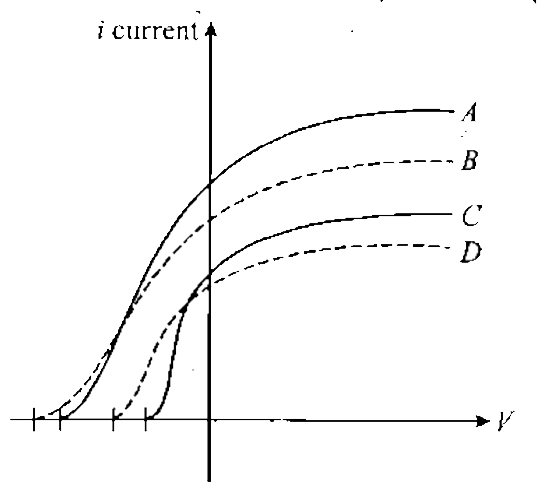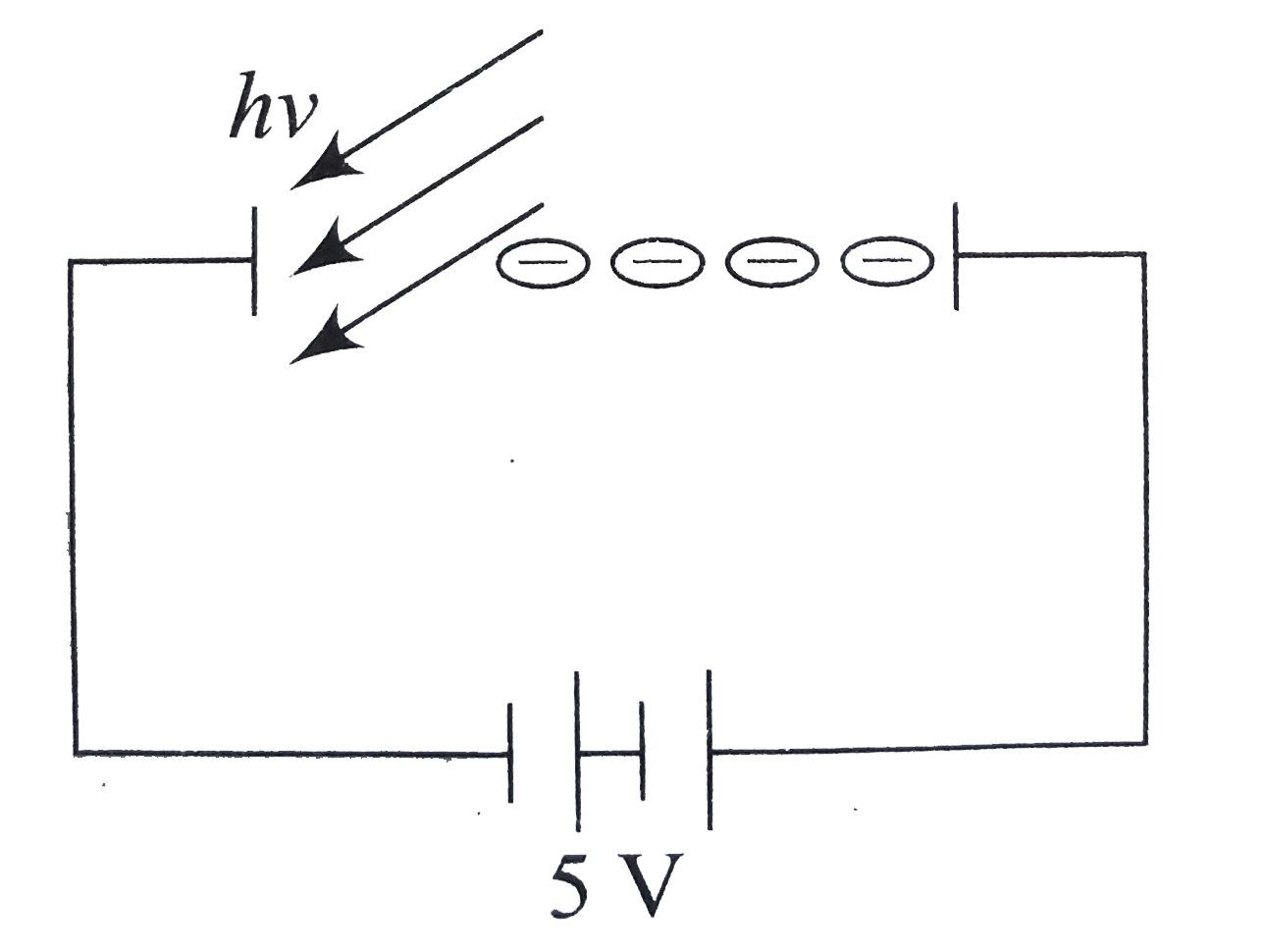Complete Solutions to Advance MCQ of chapter PHOTOELECTRIC EFFECT AND MATTER WAVES of Class 12 book with complete answers and questions
| Class 12 | PHYSICS |
| Chapter | PHOTOELECTRIC EFFECT AND MATTER WAVES |
| PHYSICS GALAXY | Advance MCQ |
| Number Of Questions | 28 |
| Academic Year | 2023-24 |
A collimated beam of light of flux density `30kWm^(-2)` is incident normally on `100mm^(2)` completely absorbing screen. If P is the pressure exerted on the screen and `trianglep` is the momentum tranferred to the screen during a 1000 s interval, then
02:20View SolutionIn a photoelectric experiment, the collector plate is at 2.0V with respect to the emitter plate made of copper `(phi)=4.5eV)`. The emitter is illuminated by a source of monochromatic light of wavelength 2000 `Å`nm.
02:51View SolutionThe work function for aluminium surface is 4.2 eV and that for sodium surface is 2.0 eV. The two metals were illuminated with appropriate radiations so as to cause photo emission. Then :
01:38View SolutionThe stopping potential for the photoelectrons emitted from a metal surface of work function 1.7 eV is 10.4 V. Find the wavelength of the radiation used. Also, identify the energy levels in hydrogen atom, which will emit this wavelength.
02:00View Solution` H^(+), He^(+) and O^(++)` all having the same kinetic energy pass through a region in which there is a uniform magnetic field perpendicular to their velocity . The masses of ` H^(+), He^(+) and O^(2+)` are `1 amu, 4 amu and 16 amu` respectively . Then
02:55View SolutionWhen an electron of hydrogen like atom jumps from a higher energy level to a lower energy level.
01:20View SolutionLight rays are incident on an opaque sheet. Then they:
01:34View SolutionThe angular momentum of an electron in an orbit is quantized because:
01:31View SolutionThe intensity of light falling on a phototube is increased while keeping the no of photons falling per seconds constant then for a given experiment.
01:36View SolutionTwo photocathodes are illuminated by the light emitted by a single source. The dependence of photocurrent versus voltages between cathode and anode is shown by curves 1 and 2 as shown in the figure. (I/I_(max) represents ratio of photocurrent to saturation current):
 03:27View Solution
03:27View SolutionPhotoelectric effect supports quantum nature of light because
(a) there is a minimum frequency of light below which no photo electrons are emitted
(b) the maximum kinetic energy of photo electrons depends only on the frequency of light and not on its intensity
(c ) even when the metal surface is faintly illuminated, the photo electrons leave the surface immediately
(d) electric charge of the photo electrons is quantised01:32View SolutionThe momentum of a single photon of red light of fequency `400 xx 10^(12)`Hz moving through free surface is given as:
01:57View SolutionWhen a monochromatic point source of light is at a distance
of 0.2 m from a photoelectric cell, the cut off voltage and the saturation current
are respectively 0.6 V and 18.0 mA. If the same source is placed 0.6 m away
from the photoelectric cell, then
(a) the stopping potential will be 0.2 V
(b) the stopping potential will be 0.6 V
(c ) the saturation current will be 6.0 mA
(d) the saturation current will be 2.0 mA02:15View SolutionIn a photoelectric experiment, the collector plate is at 2.0 V with respect to the emitter plate made of copper. The emitter is illuminated by a source of monochromatic light of wavelength 200nm. Find the minimum and maximum kinetic energy of the photoelectrons reaching the collector.
05:58View SolutionA small mirror of area A and mass m is suspended in a vertical plane by a weightless string. A beam of light of intensity I falls normally on the mirror and the string is deflected from the vertical by a very small angle `theta` Assuming the mirror to be perfectly reflecting, obtain an expression for `theta`
07:57View SolutionWhen photons of energy `4.25 eV` strike the surface of metal A, the ejected photoelectrons have maximum kinetic energy `T_(A)` eV and De-broglie wavelength `lambda_(A)`. The maximum energy of photoelectron liberated from another metal B by photon of energy 4.70 eV is `T_(B) = (T_(A) - 1.50) eV` if the de Brogle wavelength of these photoelectrons is `lambda_(B) = 2 lambda_(A) `, then
07:33View SolutionIn photoelectric effect, stopping potential depends on
02:23View SolutionThefigure shows the results of an experiment involving photoelectric effect. The graphs A, B,C and D relate to a light beam having different wavelengths. Select the correct alternative.
 03:29View Solution
03:29View Solutionthe photoelectric effect can not be explained by the wave theory of light because:
02:34View SolutionA non-monochromatic light is used in an experiment on photoelectric effect. The stopping potential
04:23View SolutionIn a phtoelectron effect energy of photon is directly proportional to the frequency and photons are totally absorbed by the electrons of metals then frequency and photons are totally absorbed by the electrons of metals then photoelectric current is:
02:01View SolutionSuppose frequency of emitted photon is `f_(0)` when the electron of a stationary hydrogen atom jumps from a higher state `m` to a lower state `n`. If the atom is moving with a velocity `v(lt lt c)` and emits a photon of frequency `f` during the same transition,then which of the following statement are possible?
03:10View SolutionA small miror is suspended by a thread as shownin figure 2.35. A short pulse of mono-chromatic light rays is incident normally on the mirror and gets reflected. Which of the following statements is/are correct?
 01:45View Solution
01:45View SolutionWhen monochromatic light falls on a photosensitive material, the number of photoelectrons emitted per second is n and their maximum kinetic energy is `K_(max)`. If the intensity of the incident light is doubled keeping the frequency same, then:
01:23View SolutionMark the correct statement(s) related to the stopping potential difference.
01:32View SolutionIf the wavelength of light in an experiment on photo electric effect is doubled,
02:28View SolutionPhotoelectric effect supports quantum nature of light because
03:50View Solution
Photons of energy 5eV are incident on the cathode. Electrons reaching the anode have kinetic energies varying from 6eV to 8eV. Find the work function of the metal and state whether the current in the circuit is less than or equal to saturation current.03:16View Solution
Advance MCQ questions and complete solutions for chapter PHOTOELECTRIC EFFECT AND MATTER WAVES of GK PUBLICATIONS PHYSICS (HINGLISH) of Class 12
